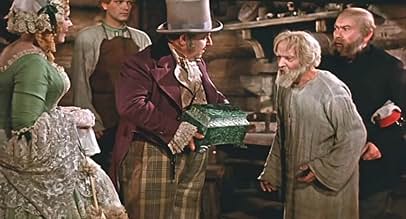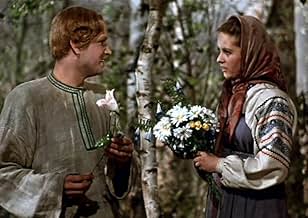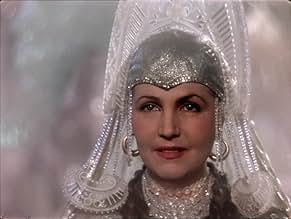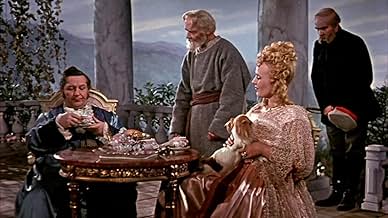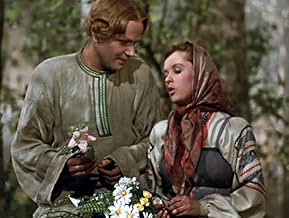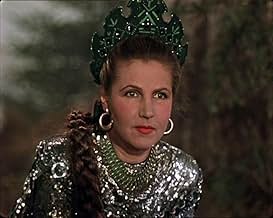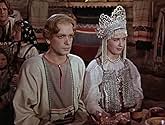IMDb RATING
7.1/10
558
YOUR RATING
Obsessed with perfecting his craft, young gemcutter Danilo visits the mystical Copper Mountain to uncover the secret behind its infamous attraction - the Stone Flower, a stone carving so cap... Read allObsessed with perfecting his craft, young gemcutter Danilo visits the mystical Copper Mountain to uncover the secret behind its infamous attraction - the Stone Flower, a stone carving so captivating that no one can leave after seeing it.Obsessed with perfecting his craft, young gemcutter Danilo visits the mystical Copper Mountain to uncover the secret behind its infamous attraction - the Stone Flower, a stone carving so captivating that no one can leave after seeing it.
- Director
- Writers
- Stars
- Awards
- 2 wins & 2 nominations total
Vladimir Druzhnikov
- Danilo - master
- (as V. Druzhnikov)
Yekaterina Derevshchikova
- Katya
- (as Y. Derevshchikova)
Mikhail Troyanovskiy
- Prokopych
- (as M. Troyanovsky)
Mikhail Yanshin
- Severyan
- (as M. Yanshin)
Nikolay Temyakov
- Barin
- (as N. Temyakov)
Anna Petukhova
- Barina
- (as A. Petukhova)
Nikolai Orlov
- Stary master
- (as N. Orlov)
Lidiya Deikun
- Vikhorika
- (as L. Deikun)
Serafim Zaytsev
- Yefimka
- (as S. Zaytsev)
Vitaliy Kravchenko
- Danilo - malchyk
- (as V. Kravchenko)
- Director
- Writers
- All cast & crew
- Production, box office & more at IMDbPro
Featured reviews
An old man recounts a fairy-tale to a group of children about a stone-cutter, "Danila", who strives for perfection and meets with the mystical "Queen of Copper Hill". She asks him to sacrifice himself and remain with her in her unreachable world of stone at the expense of his married life with "Katinka", the girl he loves and whom he has just married.
The film is made in colour which is refreshing for 1946 and it is 15 minutes longer than described on IMDb. However, the story drags. The Russian hierarchy is very effectively captured - we witness the cruelties of the ruling classes who take to flogging the poor. They don't just flog them, they beat them to death for not working hard enough or not finishing a piece of work in time. Danila's talent at stone sculpture results in him being commissioned to make a piece for a wealthy landowner who wants to show off. However, the "Queen of Copper Hill" intervenes. It takes ages for this part of the story to get going, though.
Vladimir Druzhnikov is good in the lead role as "Danila". He looks a bit gay and girlie and very much suits the artistic type that is required for the film. The sets within the world of stone in Copper Hill are interesting in a "Star Trek" kind of way but each section of the film just seems to drag on for too long. Apart from the dance sequence in the wedding episode - one of the more entertaining parts of the film.
I also felt that the ending of the film could have been better. It's a happy-ending story but it would have been far more effective as a tragedy. We are led to believe that the Queen of Copper Hill has an evil sacrifice up her sleeve and that someone is going to get turned to stone for eternity. This is exactly what the film needs. But it doesn't happen. She suddenly switches to a goodie and we get a "love conquers all" message which is a disappointment. The film keeps you watching with false expectations and I felt cheated at the end. The rules suddenly change from "You can never go back!" to "Ok you can go back now". Very lame. The film needed an effective finale, ie, some tragedy, to redeem the rest of the tedious film but it didn't happen. It scores for novelty value only.
The film is made in colour which is refreshing for 1946 and it is 15 minutes longer than described on IMDb. However, the story drags. The Russian hierarchy is very effectively captured - we witness the cruelties of the ruling classes who take to flogging the poor. They don't just flog them, they beat them to death for not working hard enough or not finishing a piece of work in time. Danila's talent at stone sculpture results in him being commissioned to make a piece for a wealthy landowner who wants to show off. However, the "Queen of Copper Hill" intervenes. It takes ages for this part of the story to get going, though.
Vladimir Druzhnikov is good in the lead role as "Danila". He looks a bit gay and girlie and very much suits the artistic type that is required for the film. The sets within the world of stone in Copper Hill are interesting in a "Star Trek" kind of way but each section of the film just seems to drag on for too long. Apart from the dance sequence in the wedding episode - one of the more entertaining parts of the film.
I also felt that the ending of the film could have been better. It's a happy-ending story but it would have been far more effective as a tragedy. We are led to believe that the Queen of Copper Hill has an evil sacrifice up her sleeve and that someone is going to get turned to stone for eternity. This is exactly what the film needs. But it doesn't happen. She suddenly switches to a goodie and we get a "love conquers all" message which is a disappointment. The film keeps you watching with false expectations and I felt cheated at the end. The rules suddenly change from "You can never go back!" to "Ok you can go back now". Very lame. The film needed an effective finale, ie, some tragedy, to redeem the rest of the tedious film but it didn't happen. It scores for novelty value only.
For the commentator below, I thought I had seen it on tape but I'm not sure. Most probably saw it an art house in Chicago or some university festival (Roosevelt University had a very good one back then).
The film's use of color was a landmark breakthrough. It was a process different and superior to technicolor. We can do it today in say, Kodacolor, and "The Red Shoes" did indeed quite approximate it but good as that was, it did not equal SF,
I wonder if Martin Scorcese, who did a commentary for "The Red Shoe" saw it. I'm sure he would have been impressed and if someone could get to him today he might even promote putting it on DVD just for gras artis gras.
The film was of some importance politically too in that it was the first kind of cultural exchange gesture the Soviets made at the height of the cold war. We probably sent them "Gone With The Wind." I mean that.
The film's use of color was a landmark breakthrough. It was a process different and superior to technicolor. We can do it today in say, Kodacolor, and "The Red Shoes" did indeed quite approximate it but good as that was, it did not equal SF,
I wonder if Martin Scorcese, who did a commentary for "The Red Shoe" saw it. I'm sure he would have been impressed and if someone could get to him today he might even promote putting it on DVD just for gras artis gras.
The film was of some importance politically too in that it was the first kind of cultural exchange gesture the Soviets made at the height of the cold war. We probably sent them "Gone With The Wind." I mean that.
10holcombe
I saw "The Stone Flower" in 1952 at Iowa State University's (then a state college) student union. I was a second or third grader, but I have never forgotten the magic of this Russian fable, the movie's gorgeous images and its powerful drama. I remember a wicked queen who turned the heroine into stone and the soft images of the lush rose-colored stone flower that remained for the hero to find after great struggles with the evil queen and her sinister minions.
Some sets were simple and rather bare. I like the earlier comment about "The Red Shoes," another post-war film from the recovering European film industries, with the same pre-war quality story lines and great effort to use color and images well, but with truly scarce resources.
I am so thrilled to find that others remember this wonderful film that seemed to have disappeared. I hope someone can find a print to share with film historians and certainly with other children. More than 50 years later, I can thank my mother for taking me to share the beautiful Stone Flower that I have never forgotten.
Some sets were simple and rather bare. I like the earlier comment about "The Red Shoes," another post-war film from the recovering European film industries, with the same pre-war quality story lines and great effort to use color and images well, but with truly scarce resources.
I am so thrilled to find that others remember this wonderful film that seemed to have disappeared. I hope someone can find a print to share with film historians and certainly with other children. More than 50 years later, I can thank my mother for taking me to share the beautiful Stone Flower that I have never forgotten.
I saw The Stone Flower as somebody who really liked some of Aleksandr Ptusko's other films like Ruslan and Ludmilla, Sampo and Sadko(which is only to be seen in the original Russian version, the dub ruins it), and is having a great run of Russian fairy/folk-tale films. It was also highly recommended by commentators for those respective films, regarding it as one of his best/one of their favourites of his. I am happy that there are people who remember The Stone Flower very fondly, I am one of those newly-acquainted with it from Youtube rather than those who saw it in childhood. I am also glad that I saw it, as it really is as good as people say it is, and for me it is one of Ptushko's best. It is a gorgeous film to look at, the scenery is enough to take your breath away and the film is beautifully shot as well. It is very easy to be taken by the music score as well, because it does have a sense of fantasy and adventure, it sounds very Russian in its songs and its nationalistic feel, it is lusciously orchestrated and sometimes even sounds like a tender tone poem. The dialogue is well-incorporated within the story and sounds generally natural and sincerely delivered. The story is a magical one, it unfolds beautifully and packs a very powerful punch. It does move slowly particularly in the middle, but that is not a bad thing, if anything it gave the story a sense of freedom, time to breathe and allowed us to become invested in the characters and story and also admire the Russian culture. The characters all engage, especially the wicked Copper witch, they are fairy-tale clichés certainly but that is not to be taken as a bad thing. The acting is good, the hero is noble and sincere and the Copper Witch is both entrancing and icy. I personally didn't see the ending as that much of a cheat, there have been far worse ending cheats around. Though I do think also that The Stone Flower perhaps could've been even more powerful if ended tragically. All in all, magical. 10/10 Bethany Cox
I saw The Stone Flower back in the forties shortly after it was released. I have never forgotten it. The color was so amazing that some of the images have remained permanently imprinted in my brain! I am disappointed that it is unavailable on video nor have I ever seen t revived anywhere where I have been. I am glad there are at least a few others who remember it.
Did you know
- ConnectionsFeatured in Adieu l'URSS! (2021)
Details
- Release date
- Country of origin
- Language
- Also known as
- The Stone Flower
- Filming locations
- Production company
- See more company credits at IMDbPro
- Runtime1 hour 29 minutes
- Sound mix
- Aspect ratio
- 1.37 : 1
Contribute to this page
Suggest an edit or add missing content


